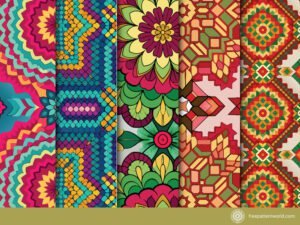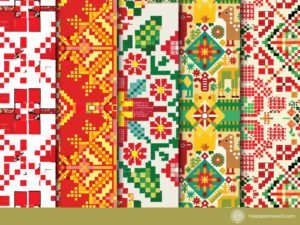
Table of Contents
Introduction
Geometric patterns, with their precision, symmetry, and mathematical elegance, have intrigued and inspired humanity for centuries. These mesmerizing patterns transcend cultural boundaries and find their place in art, architecture, design, and even mathematics. In this exploration, we delve into the world of geometric patterns, uncovering their historical significance, artistic applications, and the mathematical principles that underlie their captivating allure.

The Origins of Geometric Patterns
Ancient Mesopotamia and Babylon (c. 4000 BCE)
The earliest recorded geometric date back to ancient Mesopotamia and Babylon. Clay tablets with intricate geometric designs have been discovered, showcasing the early human fascination with symmetry and repetitive shapes.
Islamic Geometric Patterns (7th to 17th Century)
Islamic art and architecture, particularly during the Golden Age of Islam, embraced geometric known as arabesques. These patterns, featuring complex interlocking shapes and symmetrical tessellations, adorned mosques, palaces, and manuscripts.

Geometry and Art: The Renaissance and Beyond
Renaissance Italy (14th to 17th Century)
During the Renaissance, Italian artists like Leonardo da Vinci and Piero della Francesca explored the mathematical principles of geometry in their art. Leonardo’s Vitruvian Man, a perfect blend of art and geometry, remains an iconic representation of this era.

M.C. Escher: The Geometric Illusionist
M.C. Escher, a 20th-century Dutch artist, gained worldwide acclaim for his mind-bending geometric lithographs. His art challenged perceptions of space and reality, using mathematical concepts like tessellations and impossible constructions.
Geometric Patterns in Architecture
Islamic Architecture
Islamic architecture features stunning geometric patterns, often representing infinite repetition and divine symmetry. The intricate tiles, called “zellige,” found in Moroccan architecture, exemplify this tradition.
Gothic Architecture
Gothic cathedrals incorporated geometric in their stained glass windows and vaulted ceilings. These patterns added to the spiritual experience, reflecting the harmony of the divine order.

The Mathematical Magic Behind Geometric Patterns
Tessellations
Tessellations are arrangements of shapes, often polygons, that completely cover a surface with no overlaps or gaps. Renowned artist M.C. Escher was fascinated by tessellations and created many famous works using them.
The Golden Ratio
The golden ratio, a mathematical constant denoted by the Greek letter phi (φ), appears in various geometric patterns and is associated with beauty and aesthetic proportion. It can be found in the Parthenon’s architecture and even in the growth patterns of plants.

Geometric Patterns in Modern Design
Geometric Fashion
Geometric have made a significant impact on the world of fashion. Designers incorporate bold shapes, lines, and symmetry into clothing, accessories, and even footwear, creating visually striking and contemporary looks.
Interior Design
In interior design, geometric are used to add depth and visual interest to spaces. From geometric wallpapers to furniture and decor, these patterns can transform a room’s ambiance.

The Cultural Significance of Geometric Patterns
Computer Graphics
In computer graphics and digital art, geometric patterns play a vital role. They are used to create textures, backgrounds, and visual effects in video games, animations, and graphic design.
Fractals
Fractals, which are complex geometric that repeat at different scales, have applications in diverse fields such as physics, biology, and computer science. They help model natural phenomena like coastlines and mountain ranges.
The Cultural Significance of Geometric Patterns
Indigenous Art
Indigenous cultures worldwide use geometric patterns in their traditional art forms. These patterns often carry deep cultural and spiritual significance, reflecting their unique worldviews and stories.
Conclusion
Geometric patterns are a testament to the human fascination with order, symmetry, and mathematical beauty. From ancient Mesopotamia to modern computer graphics, they have left their mark on art, architecture, design, and science. Whether adorning the walls of a mosque, gracing the pages of a mathematical textbook, or inspiring a contemporary fashion collection, geometric continue to captivate our imagination and connect us to the timeless world of mathematics and art. In the intricate lines and perfect shapes of these patterns, we discover a fascinating intersection of creativity and precision, a testament to the enduring allure of geometry in our lives.
Download more free pattern designs from freepatternword and freepik.
What are some famous examples of geometric patterns in architecture?
Some famous examples include the intricate tiles in Moroccan architecture, Gothic stained glass windows in cathedrals, and the use of geometric shapes in the Parthenon’s design.
Can you explain the mathematical concept of tessellations in more detail?
Tessellations are arrangements of shapes (often polygons) that completely cover a surface with no overlaps or gaps. They create repeating patterns and can be found in various art forms and architecture.
What is the golden ratio, and how does it relate to geometric?
The golden ratio, denoted as φ (phi), is a mathematical constant associated with aesthetic proportion and beauty. It appears in many geometric patterns and is often considered an ideal ratio for design and art.
How have geometric influenced modern fashion and interior design?
Geometric patterns have been used to create visually striking designs in both fashion and interior design. From clothing to decor, they add a contemporary and visually appealing element to these fields.
Can you provide examples of modern technology and fields where geometric play a significant role?
Geometric pattern are used in computer graphics, digital art, and fields like architecture, physics, biology, and computer science. They help create visual effects, model natural phenomena, and enhance designs.
Who is M.C. Escher, and what made his geometric art famous?
M.C. Escher was a Dutch artist known for his mind-bending geometric lithographs. His art challenged perceptions of space and reality, using mathematical concepts like tessellations and impossible constructions.



